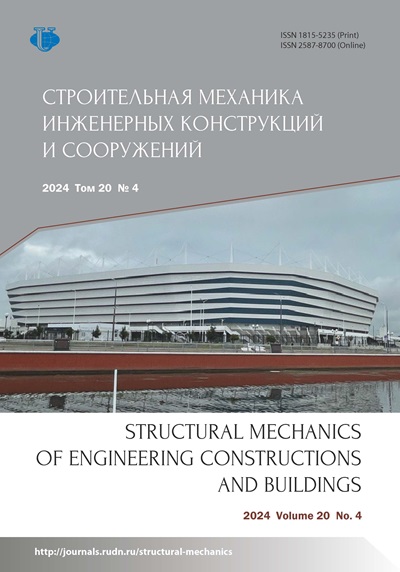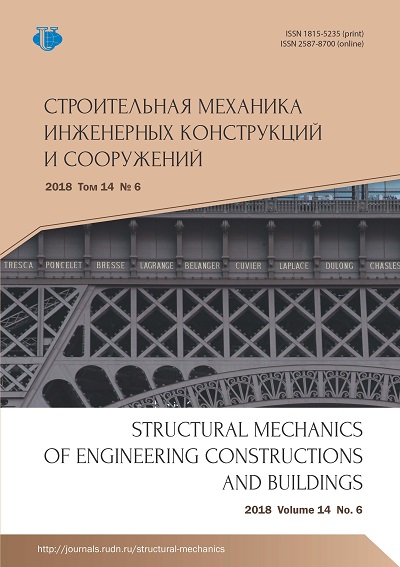Effect of stress concentration in a beam of rectangular cross section in the region of attachment of the longitudinal efforts
- Authors: Yakupov S.N1,2, Kiyamov H.G1, Yakupov N.M1, Khasanova L.I2, Bikmukhammetov I.I2
-
Affiliations:
- Kazan Scientific Center of the Russian Academy of Sciences
- Kazan State University of Architecture and Engineering (KSUAE)
- Issue: Vol 14, No 6 (2018)
- Pages: 451-458
- Section: Numerical methods of structures’ analysis
- URL: https://journals.rudn.ru/structural-mechanics/article/view/20422
- DOI: https://doi.org/10.22363/1815-5235-2018-14-6-451-458
Cite item
Full Text
Abstract
Relevance. To ensure the safe operation of buildings and structures, it is necessary to more accurately determine the stress-strain state (SSS) of structural elements, to identify areas of stress concentration. The distribution of stresses in the region of the fastening bars in three-dimensional formulation is relatively little studied. In these areas, there may be significant stress concentrations that contribute to the occurrence and development of cracks and splits, which are a harbinger of destruction. The development of modern methods of calculation, software systems and the growth of computing capabilities allow refining the design scheme: to move from one-dimensional to two-dimensional calculation scheme, from two-dimensional to three-dimensional calculation scheme. All this makes it possible to more accurately assess the SSS of structural elements and structures, to identify areas of stress concentration, as well as to investigate the effect of the Poisson's ratio on the stress concentration. Methods of research. It is noted that cracks and breaks in the edges under the influence of longitudinal loads occur in the rods (racks) of square cross-section. Three-dimensional elements based on the spline version of the finite element method and the LIRA computational complex are used to estimate the stress-strain state. The spline finite element method, thanks to the synthesis of the idea of parametrization and the finite element method (FEM) with cubic approximation of all three required variables within each element, allows obtaining consistent three-dimensional finite elements. On the basis of the mentioned methods and complexes, numerical studies of the stress concentration in the bars of square and rectangular cross-sections fixed at one end and perceiving the tensile forces at the other end are performed. Conclusions. It is found that in the angular points of the cross section in the area of fastening of straight bars, perceiving axial tensile forces, there are stress concentrations. Away from the mounting area of the bar, the voltages are aligned. By increasing the Poisson's ratio, the stress concentration increases faster than at low values. The transition from a onedimensional design model to a two-dimensional one, and even more so to a three-dimensional model allows to determine the stress concentration, both in plan and in thickness. Information about the concentration of stresses in elements of structures will allow designers to more accurately design structures and facilities, and the operators to promptly identify the defective region.
About the authors
Samat N Yakupov
Kazan Scientific Center of the Russian Academy of Sciences; Kazan State University of Architecture and Engineering (KSUAE)
Author for correspondence.
Email: tamas_86@mail.ru
Cand. Sci. (Eng.), senior researcher, Institute of Mechanics and Engineering
2/31 Lobachevsky St., PO Box 261, Kazan, Tatarstan, 420111, Russian Federation; 1 Zelenaya St., Kazan, Tatarstan, 420043, Russian FederationHakim G Kiyamov
Kazan Scientific Center of the Russian Academy of Sciences
Email: tamas_86@mail.ru
Cand. Sci. (Eng.), senior researcher, Institute of Mechanics and Engineering
2/31 Lobachevsky St., PO Box 261, Kazan, Tatarstan, 420111, Russian FederationNukh M Yakupov
Kazan Scientific Center of the Russian Academy of Sciences
Email: yzsrr@kfti.knc.ru
Dr Sci. (Eng.), leading researcher, Institute of Mechanics and Engineering
2/31 Lobachevsky St., PO Box 261, Kazan, Tatarstan, 420111, Russian FederationLeisan I Khasanova
Kazan State University of Architecture and Engineering (KSUAE)
Email: leisanka15@mail.ru
master
1 Zelenaya St., Kazan, Tatarstan, 420043, Russian FederationIlnar I Bikmukhammetov
Kazan State University of Architecture and Engineering (KSUAE)
Email: ilnar_27@mail.ru
master
1 Zelenaya St., Kazan, Tatarstan, 420043, Russian FederationReferences
- Neuber H. (1946). Theory of Notch Stress. Ann Arbor, Mich., J.W. Edwards, 204.
- Peterson R.E. (1974). Stress Concentration Factors. New York, J. Wiley & Sons.
- Collins J.A. (1981). Failure of Materials in Mechanical Design. Analysis, Prediction, Prevention. The Ohio State University; New York, J. Wiley & Sons.
- Yakupov N.M. (2010). Mechanics: problem – idea – practice. Kazan, Kazan State University Publ., 161. (In Russ.)
- Kantyukov R.A., Tameev I.M., Yakupov N.М., Abdushev А.А., Yakupov S.N. (2011). Local “treating” overlays-coatings. Territorija Neftegas, 1(18), 68–71.
- Yakupov N.M., Rizaeva A., Khusnutdinov A.E., Mojaddidi A.S. (2015). Concentration of stresses in the stretched rod in the region of the seal. Proceedings of VIII International Scientific-Practical Conference “Engineering systems – 2015”. Moscow, RUDN Publ., 69–73. (In Russ.)
- Shardakov I.N., Kosheleva N.A., Serovaev G.S., Shestakov A.P., Shipunov G.S. (2018). The stress-strain state analysis and structural evaluation of PCM construction consisting of heterogeneous element. International Journal of Mechanical Engineering and Technology (IJMET), 9(10), 1157–1171.
- Gunakala S.R., Comissiong D.M.G., Jordan К., Sankar A. (2012). A Finite Element Solution of the Beam Equation via MATLAB. International Journal of Applied Science and Technology, 2(8), 80–88.
- Sidorenko S.N., Yakupov N.M. (2002). Corrosion is an ally of accidents and catastrophes. 93.
- Nizamov H.N., Sidorenko S.N., Yakupov N.M. (2006). Forecasting and prevention of corrosion destruction of structures. 355.
- Yakupov N.M., Giniyatullin R.R., Yakupov S.N. (2012). The effect of deformation of the surface structure elements on the corrosion wear. Strength problems, 2, 76–84.
- Yakupov N.M., Giniyatullin R.R., Yakupov S.N. (2012). The influence of the character of deformation of structural element surfaces on the corrosive wear. Strength of materials, 170–176.
- Meneghetti G., Guzzella C. (2014). The peak stress method to estimate the mode I notch stress intensity factor in welded joints using three-dimensional finite element models. Engineering Fracture Mechanics, 115, 154–171.
- You F.X. (2011). The Spline Finite Element Method for the Analysis of the Dynamic Response of Composite Material Plate. Advanced Materials Research, 168–170, 1837–1845.
- Yakupov N.M., Kiyamov H.G., Yakupov S.N., Kiyamov I.Kh. (2011). Modeling of structural elements of complex geometry by three-dimensional finite elements. Mechanics of composite materials and structures, (1), 145–154. (In Russ.)
- Lim T.C. (2013). Stress Concentration Factors in Auxetic Rods and Plates. Applied Mechanics and Materials, 394, 134–139.
















